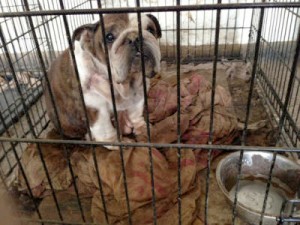 Since the last post, the site authors have acquired another bulldog thanks to Long Island Bulldog Rescue. Her name is Baby Cow. Why? Look at her! She looks like a little tiny cow.
Since the last post, the site authors have acquired another bulldog thanks to Long Island Bulldog Rescue. Her name is Baby Cow. Why? Look at her! She looks like a little tiny cow.
 Since the last post, the site authors have acquired another bulldog thanks to Long Island Bulldog Rescue. Her name is Baby Cow. Why? Look at her! She looks like a little tiny cow.
Since the last post, the site authors have acquired another bulldog thanks to Long Island Bulldog Rescue. Her name is Baby Cow. Why? Look at her! She looks like a little tiny cow.

Southern California Bulldog Rescue (SCBR) recently acquired 12 English Bulldogs from a garage in Los Angeles County. Acting on a tip, authorities from the Los Angeles County Department of Animal Care and Control (DACC) found the dogs in unsanitary conditions. They were part of an illegal breeding operation. (To avoid backyard breeders and puppy mills, see our tips on finding a bulldog.)
The dogs join 70 other English bulls that are currently in the care of SCBR. As a result of their owner’s neglect, the 12 additional dogs will require rather extensive medical care. SCBR estimates it spends $15,000 a month caring for the dogs it currently has.
Now the good news, these dogs are adoptable, “One of the tragic things about backyard breeders is the manner in which they house and keep their animals. It is often times very inhumane and their primary goals are financially driven,” County of Los Angeles Department of Animal Care and Control Deputy Director Aaron Reyes said. “These animals do need care and do need to be socialized and exercised. We’re happy to say they’re a very well-mannered bunch, just unfortunately, a neglected bunch.”
You can help by donating to the SCBR through Crowdrise. All donations are tax deductible. Here at Where’s Pom, we’ve already donated. We can’t leave a bulldog behind.
Read more: [SoCal Bulldog Rescue | The Story | And More…]

The Humane League of Lancaster is running a holiday promotion showcasing their special needs pets. In reading through the descriptions, these little guys may require a little extra patience, some medication, or a quiet home in order to thrive. There are several cats and one dog named Dutch, who is pictured here. Dutch, like a few of the cats available, was injured by a car. If you have a special home, check them out here:
 I’ve been waiting for this moment on Where’s Pom. The story where Lancaster and the mission of this blog combine. Unfortunately, this post covers some well traveled territory – the ongoing public battle between townships and the local Humane League. It was only last December that Lancaster Online covered the same story – Humane League raises fees and local townships start complaining publicly.
I’ve been waiting for this moment on Where’s Pom. The story where Lancaster and the mission of this blog combine. Unfortunately, this post covers some well traveled territory – the ongoing public battle between townships and the local Humane League. It was only last December that Lancaster Online covered the same story – Humane League raises fees and local townships start complaining publicly.
The breakdown of the problem goes something like this:
Just over half of Lancaster’s 60 municipalities have a contract with the Humane League for 2011. Contracts are up for renewal soon, and several more municipalities say they won’t pay due to budget constraints. Back in December, Manor Township reported hauling their strays to Berks County to avoid local fees. Given $3.50-$4.00 gas and the cost of paying an employee to drive a stray to Berks County, this hardly seems like a fiscally sound idea. Moreover, as writer Tom Knapp points out for municipalities, “The cost of doing business with the Humane League is up again this year, and some municipalities are looking at options for 2012. Short of building and staffing their own kennels, there aren’t many.”
Stray dogs and cats fall clearly into the realm of “public” problems–the kind of thing you pay local taxes to take care of. Feral cats are sometimes carriers of rabies, so considering most of the stray animals caught are cats, this is also a public safety issue. Municipalities are, of course, free to consider other shelters, but in the interest of fiscal stewardship, they should also consider the additional costs incurred in transportation and compensation to transport strays.
The Humane League of Lancaster County does an admirable job of caring for and placing stray dogs and cats. The cost of their service includes a personality matching service that helps match owners with animals that will better fit their lifestyle and needs thus assuring the animals won’t be returned. Local municipalities are ill equipped to provide this same service nor should they. This blog hopes the public complaining ends and that municipalities work quietly to resolve their differences with the Humane League and continue their working relationship.
Sources:
Dog Shelter Loses Support
Stray Dogs A Costly Problem